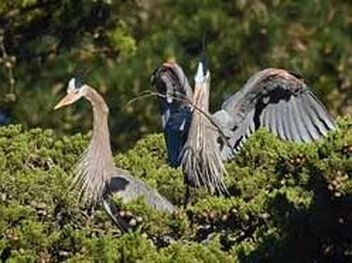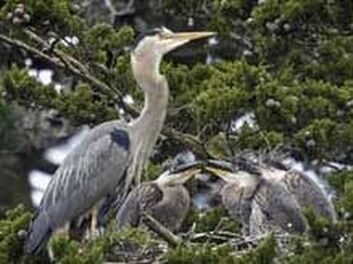Life Cycle of the Great Blue Herons at Stow Lake
Herons have been known to arrive at Heron Island as early as November. Males first occupy a favorite nest, generally an older, well-constructed nest.
In late January or February, the males begin displaying (engaging in distinctive courtship postures and behaviors) in an effort to attract a female. As soon as two herons form a pair bond, they begin constructing a new nest or adding to an existing nest.
By mid-March the female has generally laid her entire clutch of eggs (usually three or four, but sometimes as many as five eggs). Both the male and the female take turns sitting on the eggs throughout the incubation period, which lasts for 25 to 29 days.One blue heron making an offering of a branch to another
By mid to late April, the eggs have usually hatched. Both parents take turns feeding the chicks and staying with them at the nest. Great blue herons eat a variety of aquatic life - fish, frogs, and crustaceans - as well as insects and even small mammals, such as pocket gophers. The parent herons regurgitate partially digested food into the bottom of the nest for their chicks to eat.
At roughly four weeks, the chicks are left alone in the nest, and both parents can concentrate on gathering food for the rapidly growing chicks.
At approximately seven weeks, as their plumage becomes more complete, the chicks start flapping their wings vigorously and begin hopping from branch to branch.
At eight weeks, the chicks are usually ready to take their first flight.
At ten to twelve weeks, the chicks and their parents depart and go their separate ways.
In late January or February, the males begin displaying (engaging in distinctive courtship postures and behaviors) in an effort to attract a female. As soon as two herons form a pair bond, they begin constructing a new nest or adding to an existing nest.
By mid-March the female has generally laid her entire clutch of eggs (usually three or four, but sometimes as many as five eggs). Both the male and the female take turns sitting on the eggs throughout the incubation period, which lasts for 25 to 29 days.One blue heron making an offering of a branch to another
By mid to late April, the eggs have usually hatched. Both parents take turns feeding the chicks and staying with them at the nest. Great blue herons eat a variety of aquatic life - fish, frogs, and crustaceans - as well as insects and even small mammals, such as pocket gophers. The parent herons regurgitate partially digested food into the bottom of the nest for their chicks to eat.
At roughly four weeks, the chicks are left alone in the nest, and both parents can concentrate on gathering food for the rapidly growing chicks.
At approximately seven weeks, as their plumage becomes more complete, the chicks start flapping their wings vigorously and begin hopping from branch to branch.
At eight weeks, the chicks are usually ready to take their first flight.
At ten to twelve weeks, the chicks and their parents depart and go their separate ways.
PredatorsIn Golden Gate Park, the potential predators include raccoons and ravens. So far neither has struck at Stow Lake. Volunteers from the San Francisco Bay Bird Observatory placed sheet metal collars around all the trees on Heron Island to prevent raccoons from climbing the trees to reach the heron nests. All Photos by Jim Sullivan; 2006, 2007 |




